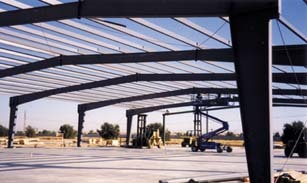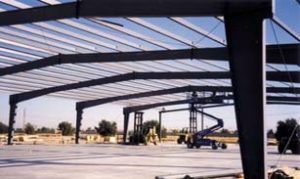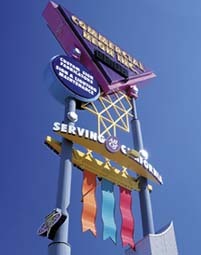Business Management
Same People, Same Service, Bigger Building
A California-based signshop is transformed into a home away from home.
Published
18 years agoon

Upon the release of her first CD, Stacey Earle recalled that her sense of accomplishment and ownership was so strong it inspired her to write a song titled, "Makes Me Happy." She says that "happy," despite its simplicity, best describes how the firstborn disk — a symbol of hard work and dedication — makes her feel.
Signmaker Jeff Tanielian, owner and operator of Commercial Neon Inc., expresses similar feelings regarding his Fresno, CA-based signshop.
He says, "The facility signifies years of hard work and commitment. I feel good every morning I come to work. That’s how happy I am."
Today, Jeff and his crew enjoy the comfort and convenience of a 20,000-sq.-ft. fabrication facility built on four acres. However, their working conditions weren’t always well-suited for the production of large-scale projects.
Too close for comfort
A self-taught signpainter since age 14, Jeff began working as a commercial-sign fabricator in the 1970s. However, when computers began to revolutionize the industry in ’80, he began to seek new opportunities.
He recalls, "I met a guy who taught me the neon trade. From him, I learned how to bend glass. This is how I gained my electrical experience."
That same year, Jeff established Commercial Neon and worked from his garage until ’84, when he purchased property and built a 5,000-sq.-ft. facility. He had one employee.
In ’89, he bought out another sign company, acquiring more production equipment. By now, Commercial Neon was quite successful, and the shop’s number of employees had grown to three. As the business continued to grow over the next several years, so did the need for a larger facility.
"We were parking across the street in a vacant lot because we used our own parking space for yard space. But this land was eventually purchased by a developer, and we could no longer park in the lot. This is when we realized it was time to move," Jeff says.
In the mid-’90s, he started looking in downtown enterprise zones for a spacious building to house his business. However, he discovered that an older building’s purchase price, plus renovation costs, were unreasonable.
He recalls, "I thought I could buy more building for less money, but that wasn’t the case. And despite a considerable amount of work, the building would never be exactly the way I wanted it to be."
His alternative — purchasing a four-acre lot across the street from his current business location — would allow him to keep his shop in a convenient, familiar area and build a facility that met his specifications. Ultimately, these advantages swayed Jeff to choose the latter option. However, two years would pass before construction was underway. He says, although he owned the property, he couldn’t build until development was complete.
"The development process took so long because the investor who purchased the land wasn’t a developer," Jeff explains. "He was inexperienced and wasn’t anxious to move forward. Also, there were some sewer issues because the property was located on the outskirts of town."
Although he was eager to begin construction, the property-development delay worked in Jeff’s favor. In ’97, he served as president of the then California Electric Sign Assn. (now the California Sign Assn., CSA), and his association obligations took precedence. He admits that overseeing the association and construction process simultaneously would have been quite challenging. Thus, he put the design and construction of the new building on the back burner until his term with the association ended.
Building a brighter tomorrow
In addition to attending a facility-planning workshop, Jeff visited shops across the country to garner ideas about sign-facility construction. From what he gleaned on his travels, he didn’t want a shop that comprised several detached buildings or a large facility composed of numerous, small work areas. He conveyed his thoughts to the project’s general contractor, architect and interior designer.
Realizing that choosing a general contractor required careful consideration, Jeff and his team reviewed bids from three potential builders.
"There was a lot of thought involved in choosing a contractor," he says. "I went through a three-bid process, which I rarely go through because it’s so time-consuming. The person we chose seemed to work a little harder for us — getting samples to us quickly and so forth."
After being awarded the job, the general contractor — who considered Jeff’s specifications for a spacious parking area and a building large enough to house maintenance trucks — drew up a site plan. From here, the project architect completed all preliminary design work (floor plans, interior elevations, etc…) and returned the print to the general contractor, who carried out the job. Construction began in April ’99 and was completed by January ’00.
Throughout the construction process, Commercial Neon employees continued fabricating signs in the existing shop, thereby eliminating any downtime. Jeff says owning the existing building proved to be a godsend because there was no rush to vacate the office, and consequently, construction of the new building wasn’t hurried.
"We didn’t want to rush construction because, in the end, we wanted a good product. Therefore, we were patient. Having the existing building from which to work was convenient. Without it, we would’ve experienced more demands and pressure," he explains.
Makin’ a move
In mid-January ’00, the Commercial Neon team moved into the new building, which was built to look like an aged, refurbished industrial warehouse. Although some people might not like the look of a metal building, Jeff says he doesn’t mind. Plus, metal proved to be a more cost-effective building material than concrete or block. To outsiders, the building’s interior appears elaborate. However, Jeff describes the offices and production areas as "functional, with a ‘techie’ look."
The shop’s art, vinyl, paint and assembly departments are four times the size of the rooms in the old facility, and no two departments share work space. Jeff jokes that the vinyl and art departments are no longer combined. Even though the neon department is also bigger, the additional space isn’t quite as noticeable due to this work area’s adequate size in the former shop.
In addition to providing a comfortable work environment, the building’s 20,000-sq.-ft. capacity has allowed the shop to purchase bigger amenities, including a 16 x 44-ft. spray booth, which required a special permit and sprinkler system, and cost the company an additional $50,000.
"Because the spray booth was such a big investment," Jeff explains, "we felt we needed to come up for air and get settled in. Therefore, we didn’t make any additional equipment purchases for a while."
To date, Commercial Neon owns a router table, sheet-metal fabrication devices and four maintenance trucks, which employees can load, unload and park inside the building. Recently, the company ordered an Autobrake CNC metal-forming system and a metal-shearing device, and anticipates a router upgrade in the near future.
Hiring new employees is also on the shop’s agenda. Commercial Neon has avoided the financial burdens of hiring new people because its existing employees, by working longer hours, are managing the shop’s workload.
"We have the capacity to handle more projects, which will require more people," Jeff says. "The building was built for the future, so we anticipate growing. We can build up to an additional 60,000 sq. ft. on this parcel."
He adds that the company’s profit margin and production flow have increased by approximately 35%. Not only can employees handle up to 10 large-scale projects simultaneously, they can juggle multiple, small-scale projects. Plus, because the new building provides more "elbow room," employees don’t waste valuable production time accommodating larger components. Another benefit is that finished projects can await pickup in the shop’s spacious assembly area without cluttering useful work space.
Jeff says that, while he’s glad the shop’s sales are continually growing, he’s not seeking an immediate return on his $1.3 million investment in acreage, building construction and new equipment purchases. He adds that he expanded to accommodate future company growth and heighten employee morale.
"I know people who’ve retired on less money than I’ve invested in my business," he says. "But the sign business has been good to me; I’ve made a good living. My people needed to grow also, and the only way for them to grow and earn more money was to expand the company."
In addition to an enlarged fabrication facility, the company gained an enhanced identity, which Jeff began brainstorming several years prior to the building’s construction. His main goal was to achieve an identifiable look that complemented the company’s name and reputation. The result is an 85-ft. pylon sign that towers over Highway 99, central California’s main thoroughfare.
Jeff says he’s very pleased with the business’s makeover, but adds that no matter how much time is spent planning a project, there’s always room for improvement and change.
He concludes, "For the most part, we got what we wanted. It makes me feel good to know we’ve got something that’s very unique. And my employees finally have room to park their cars."
Jeff Tanielian owns and operates Commercial Neon Inc., a 20,000-sq.-ft., Fresno, CA-based fabrication facility built on four acres. He says the shop, which took years to build and required a huge financial commitment, provides more than enough "elbow room" and parking space for the company’s 20 employees.

SPONSORED VIDEO
Introducing the Sign Industry Podcast
The Sign Industry Podcast is a platform for every sign person out there — from the old-timers who bent neon and hand-lettered boats to those venturing into new technologies — we want to get their stories out for everyone to hear. Come join us and listen to stories, learn tricks or techniques, and get insights of what’s to come. We are the world’s second oldest profession. The folks who started the world’s oldest profession needed a sign.
You may like

6 Sports Venue Signs Deserving a Standing Ovation

Hiring Practices and Roles for Women in Sign Companies

Avery Dennison Adopts Mimaki Printer for Traffic Sign Print System
Subscribe

Bulletins
Get the most important news and business ideas from Signs of the Times magazine's news bulletin.
Most Popular
-

 Tip Sheet3 days ago
Tip Sheet3 days agoAlways Brand Yourself and Wear Fewer Hats — Two of April’s Sign Tips
-

 Business Management1 week ago
Business Management1 week agoWhen Should Sign Companies Hire Salespeople or Fire Customers?
-

 Women in Signs2 weeks ago
Women in Signs2 weeks ago2024 Women in Signs Award Winners Excel in Diverse Roles
-

 Real Deal4 days ago
Real Deal4 days agoA Woman Sign Company Owner Confronts a Sexist Wholesaler
-

 Editor's Note1 week ago
Editor's Note1 week agoWhy We Still Need the Women in Signs Award
-

 Line Time2 weeks ago
Line Time2 weeks agoOne Less Thing to Do for Sign Customers
-

 Product Buying + Technology1 week ago
Product Buying + Technology1 week agoADA Signs and More Uses for Engraving Machines
-

 Women in Signs4 days ago
Women in Signs4 days ago2024 Women in Signs: Megan Bradley















